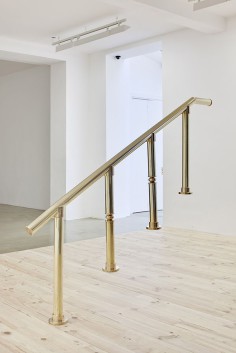Hassan Khan
Bank Bannister

source: artsynet
Working in sound, video, and performance, Hassan Khan investigates the challenges inherent in themes of identity and culture. Incorporating his own experiences growing up in Cairo, Khan has created conceptual works that attempt to construct a coherent narrative out of the city’s disparate citizens and phenomena. For The Hidden Location (2004), Khan projected four simultaneous videos of several different scenarios, some authentic and others fabricated, to fashion a portrait of Cairo made out of individuals’ private conversations and actions.
British-Egyptian, b. 1975, London, United Kingdom, based in Cairo, Egypt
.
.
.
.
.
.
.
source: artnews
while the world has its attention trained on ISIS and the traumatic events erupting in the Middle East, the Solomon R. Guggenheim Museum is taking a longer view of the region with its excellent exhibition “But a Storm Is Blowing from Paradise: Contemporary Art of the Middle East and North Africa,” curated by Sara Raza. It is the third iteration of the Guggenheim UBS MAP Global Art Initiative, which aims to add art to the museum’s collection from various underrepresented regions. Focusing on 17 artists from throughout the area, the exhibition manages to convey the importance of history behind contemporary conflicts, mostly through videos and installations that eschew ethnic stereotypes and avoid simplistic resolutions.
The exhibition takes its haunting title from a 1940 essay by German philosopher Walter Benjamin, which is in turn referred to by two works on view. The first is a series of works on paper of that same title by Iranian artist Rokni Haerizadeh, who is now living in exile in Dubai. Appropriating images from headline news photographs, Haerizadeh applies paint and gesso to transform them into fables populated by mythological creatures. Israeli artist Ori Gersht also refers to Benjamin in a two-channel video installation Evaders (2009) that conveys the philosopher’s futile attempt to escape apprehension by the Nazis and flee to the United States, all of which led to his suicide in 1940. His is a tale of migration that echoes today’s refugee crisis.
Hassan Khan, Bank Bannister (Banque Bannister), 2010, brass, 82¼ x 81⅛ x 8⅝ inches. ©HASSAN KHAN/SOLOMON R. GUGGENHEIM MUSEUM, NEW YORK, GUGGENHEIM UBS MAP PURCHASE FUND, 2015
Hassan Khan, Bank Bannister (Banque Bannister), 2010, brass, 82¼ x 81⅛ x 8⅝ inches.
©HASSAN KHAN/SOLOMON R. GUGGENHEIM MUSEUM, NEW YORK, GUGGENHEIM UBS MAP PURCHASE FUND, 2015
Many of the artists in the exhibition focus on architecture as a reflection of the history of colonialism in the region and as a metaphor for the rapid urbanization that has been taking place in recent decades. Kader Attia, who grew up in Paris and Algiers, has fashioned out of couscous a scale model of Ghardaïa, the Algerian World Heritage site whose geometric buildings influenced Le Corbusier. In another reference to that modernist architect, Kuwaiti artist Ala Younis built an installation composed of photographs, archival material, and a model peopled with miniature comical figures titled Plan for Greater Baghdad (2015), around a gymnasium in Baghdad designed by the architect in 1957 as part of Frank Lloyd Wright’s overall conception. It later opened as the Saddam Hussein Gymnasium in 1980. Fast-forward to present-day Saudi Arabia, Ahmed Mater’s Disarm and Disarm 1–10 (both 2013) display photographs and video footage shot from the cockpit of a military helicopter capturing the city of Mecca with its urban sprawl around the sacred site. Most frightening is that such technology is used regularly to track unauthorized pilgrims to the site.
One work that makes terrific use of the somewhat difficult architecture of the museum’s Tower Gallery where the exhibition is installed is Flying Carpets (2011) by Tunisian-born artist Nadia Kaabi-Linke. Composed of a stainless-steel grid hanging from the ceiling, it casts shadows resembling carpets stacked up on the floor. According to the artist, the work is a reference to the scores of undocumented migrants who lay out their wares on the streets of Venice, ready to quickly snatch them up when police arrive. Similarly, Ergin Çavuşoğlu’s installation, Dust Breeding (2011), transformed an obscure hallway looking out on Fifth Avenue with a tangle of two-dimensional lines that appeared to be a three-dimensional maze when viewed on a nearby monitor
Rather than providing viewers with easy souvenirs and tourist snapshots of an imagined Arabia, this exhibition fills the museum with intellectually challenging conceptual-art projects worthy of the time they take to comprehend. It does not pretend to survey all that is happening in the Middle East right now or to draw a list of the best artists from the region. Instead, it manages to convey in a cool, steady manner the way that this troubled part of the world is inspiring a few artists who may in turn inspire viewers to reconsider their impression of the Middle East.

